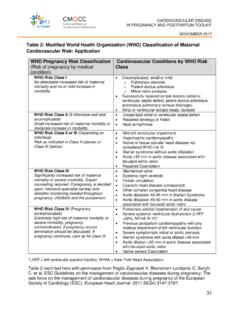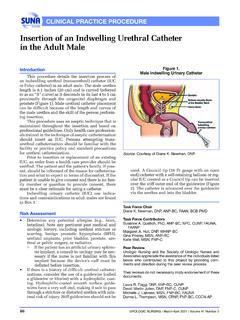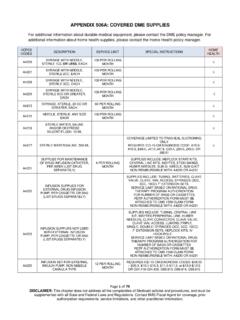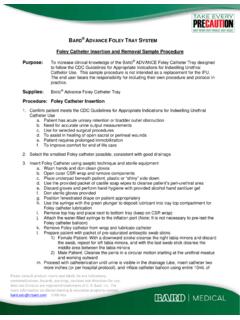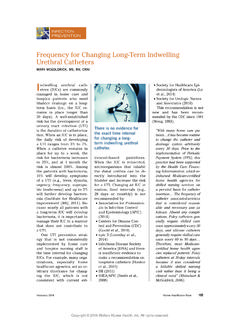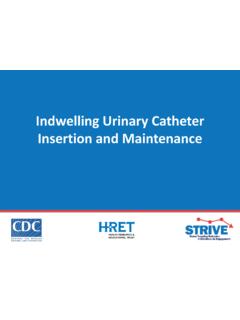Transcription of Appendix E Collecting a Urine Specimen from a Foley Catheter
1 Improving Diagnosisand Treatment of Maternal Sepsis A CMQCC Quality Improvement Toolkit 45 Appendix ECollecting a Urine Specimen from a Foley Catheter (Permission to use and adapt from Shepherd E (2017) Specimen collection 2: obtaining a Catheter Specimen of Urine . Nursing Times 113 8:20-21. urinary catheters are attached to a drainage bag to create a closed system. Breaking this closed system by disconnecting the Catheter from the drainage device can increase the risk of a patient developing a Catheter -associated urinary tract infection (CAUTI). Samples should not be collected from the drainage bag, as the Specimen may be contaminated. Ideally, samples should be collected before antibiotics are administered as they may affect the laboratory result. A Catheter Specimen must be obtained from the sampling port on the Catheter bag. Sampling ports are designed to be accessed directly using a Luer Lock syringe and do not require a Personal protective equipment ( gloves) Sterile 10ml Luer Lock syringe Non-traumatic clamp (if Catheter does not have a slide clamp) Sterile Specimen container Prep wipesProcedure (See Figure 1 on next page)1.)
2 Introduce yourself to the patient and verify the correct patient using two Explain the procedure to the patient and gain informed consent to obtain the Specimen . Explain why the Specimen is being collected, when the results will be available, and implications for Ensure the patient is comfortable and that privacy and dignity is maintained throughout the Wash your hands, prepare equipment, and apply personal protective equipment. 5. If taking a Specimen from a sampling port (Fig 1a), check first whether there is Urine in the Catheter tubing. If the tubing is empty, apply a clamp approximately 3 inches below the level of the sampling port (Fig 1b). This allows Urine to collect above the clamp so that a sample can be Clean the sampling port with a prep wipe according to policy and allow to dry (Fig 1c). 7. Stabilize the tubing by holding it below the level of the sampling Insert the syringe tip into the sampling port (following manufacturer s instructions) (Fig 1d).
3 Be careful to protect the sterile syringe tip and disinfected sampling port from Aspirate at least 10 mL of Urine and disconnect the Put the Urine into a sterile Specimen container, avoiding contact between the syringe and the cup (Fig 1e). Ensure the top of the Specimen container is secured to prevent leakage and contamination of the Wipe the sampling port with a prep swab and allow it to dry. This reduces the risk of cross infection and If a clamp was used, release it to allow Urine to drain freely. Failure to do this will cause the bladder to fill and can result in Remove and dispose of personal protective equipment, and perform hand Label the Specimen and place in a Specimen bag following Send the sample to the laboratory immediately or refrigerate until it can be transported to ensure accurate results are Document the date and time the sample was Diagnosis and Treatment of Maternal Sepsis A CMQCC Quality Improvement Toolkit Appendix ECollecting a Urine Specimen from a Foley B.
4 (2014) Specimen collection - microbiology and virology. L, Lister S. (2015) The Royal Marsden Hospital Manual of Clinical Nursing Procedures. Oxford: HP, Wilson JA, Pratt RJ, et al. epic3: National evidence-based guidelines for preventing healthcare-associated infections in NHS hospitals in England. 2014 Jan;86;Supple 1; A, and Potter, P. Clinical Nursing Skills and Techniques, 9th Edition; St. Louis, 2017, S, Clare S. ANTT: A standard approach to aseptic technique. 2011 Nurs Times Sep;13-19;107(36) Scottish Intercollegiate Guidelines Network (2015) Management of Suspected Bacterial Urinary Tract Infection in Adults. 7. Shepherd E. Specimen collection 2: obtaining a Catheter Specimen of Urine . 2017 Nurs Times [online]; 113, 8, Yates A. Urinary catheters 1: male catheterization. 2017b Nurs Times; 113: 1, to use Figure from Peter Lamb. Text was reproduced with permission of Nursing Times.


